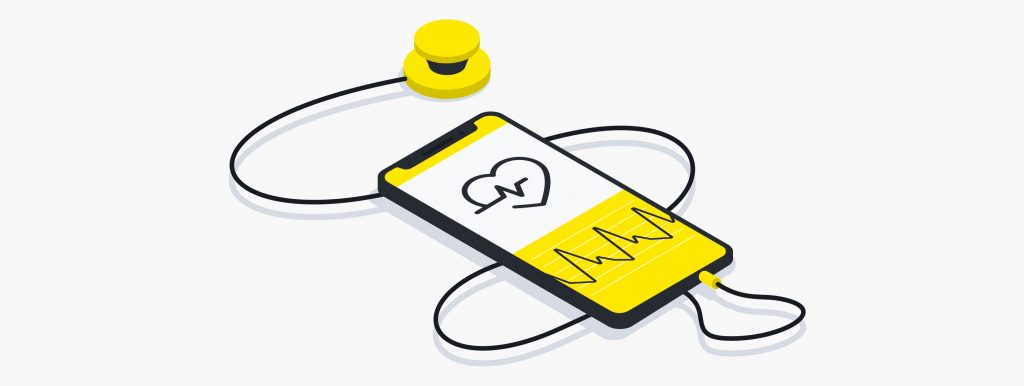Telemedicine started its development in the 19th century with the telegraph, radio, and telephone. Today, due to the rapid growth of information technology and unforeseeable challenges, such as the COVID-19 pandemic, Telemedicine has undergone great changes and is becoming a leading trend in HealthTech of 2020: around 57% of healthcare providers appreciate telehealth better than they did before the pandemic.
What is the role of Telemedicine in Healthcare today?
Telemedicine allows providing medical services at a distance utilizing the latest technologies (such as video streaming, artificial intelligence, cybersecurity). It helps physicians monitor patients remotely, improving health outcomes and simplifying access to medical care. According to Medical Economics, 93% of patients want to use telemedicine to manage prescriptions, and 91% of patients are sure that telemedicine will help to remind them about their appointments, avoid cancellations, maintain prescriptions, and follow care plans more responsibly. As a bonus, telemedicine software can improve clinics efficiency, interoperability, and optimize your resources.
What software components are essential in a Telemedicine solution?
The main goal of telemedicine software development is to improve communication between patients and healthcare specialists using emerging technologies. While evaluating telemedicine solution scope, take into account specific features that will lead your system to success:
- Secure live video streaming
Video calls are an essential part of any Telehealth platform. Development teams always pay close attention to video streaming features to ensure secure data transfer, low latency, and high video quality. You can also provide patients with an option to join the meeting in progress by generating a link that can be opened in any supported browser. - Virtual waiting room
A virtual waiting room can be compared to the usual one: the main difference is that everything is happening online. Patients waiting for their appointments can enjoy online magazines, books, videos, etc. Furthermore, a virtual waiting room allows patients to test their cameras and microphones before starting a consultation and to inform doctors about their readiness to start the appointment. You can also inform patients about the number of people in a virtual queue and approximate waiting time.Implementing a virtual waiting room also gives you the opportunity to establish mutually beneficial relations with your commercial partners: you can advertise medical products or promote new medical services in your clinic and generate profit as a promoter. - Live chat support
Live chats provide your users with easy and fast real-time messaging, enabling secure exchanging of files and documents: a system meeting DICOM standard allows a doctor to immediately see and evaluate medical images. By the way, you can also implement Artificial Intelligence or Computer Vision for preliminary assessment that will provide doctors with predictions based on deep learning algorithms outcomes.Another way of using AI for communication is chatbots that can reply to patients’ messages, analyze acquired data, and send this information to the corresponding medical personnel. Thus, a bot can simplify the record-keeping processes and help healthcare workers save time to enable 24/7 patients assistance. - Virtual front-desk triage & scheduling
While developing a telemedicine system, you should also pay attention to the convenient tools for scheduling appointments. The appointments should be easily set, modified, and tracked by patients and medical staff. The important thing to remember in online scheduling coordination is to provide certain categories of users (such as a patient, admin, or a doctor) with secure access to personal health-related information. In this way, you ensure that it will remain confidential. - EMR integration
Many telehealth providers are considering the integration of Telemedicine solutions with existing EMR systems to provide convenient and secure medical data transfer. Using EMR platforms in telemedicine apps can considerably improve the interoperability between healthcare providers and health-related delivery systems.EMR systems collect health-related data, including images from smartphones, wearable, and clinical devices as well as connected apps, by saving it securely in one place. For example, MEDsafe, a custom web-based health record system by Exposit, meets all security standards and allows patients to share personal data in a Telemedicine app in a convenient and secure way. - HIPAA compliance
Secure exchange of medical information is governed by various international standards and regulations. One of them is the Health Insurance Portability and Accountability Act. To avoid stiff penalties, you have to comply with HIPAA as well as GDPR, PIPEDA, PHIPA, and other data protection regulations.HIPAA standard regulates the usage of sensitive patient health information both on paper and in an electronic form. HIPAA regulations apply to any data transmitted over the Internet, including video appointments, text messages, and sharing documents. By the way, Exposit Healthcare experts have HIPAA certificate assistance experience and can support your product in getting compliant with information security standards.
Telemedicine has made a significant impact on the delivery of healthcare services and evolved hype technology into an essential part of the patient-centric Healthcare workflow. While developing telemedicine apps, you should pay attention to various aspects, such as video quality, schedule control, and data security, to create an upscale application that will meet your patients’ needs and bring valuable health outcomes.
Healthcare software development and Media Streaming platforms
Historically, our expertise has been shaped around Healthcare software development and Media Streaming platforms. Today this combination helps us to deliver quality human-centered Telemedicine software considering the most important aspects of remote care services. If you want to bring digital transformation to your Healthcare workflow, Exposit is always ready to provide you with a quality Telemedicine solution and support you in getting compliant with IT security standards, including HIPAA, ISO, etc.






